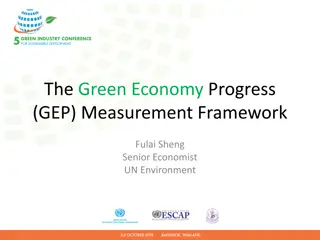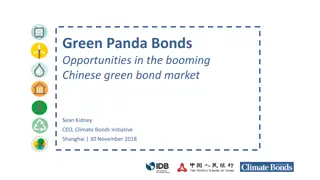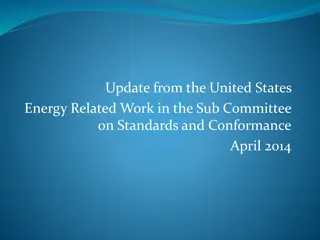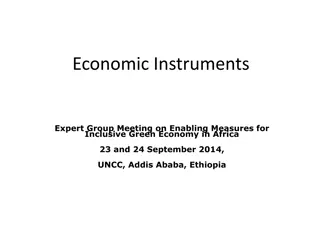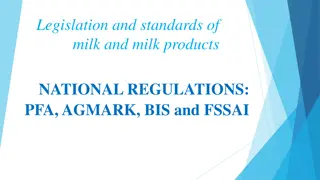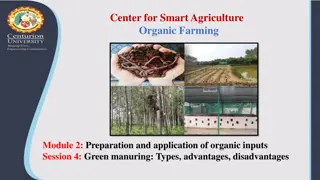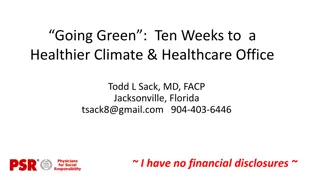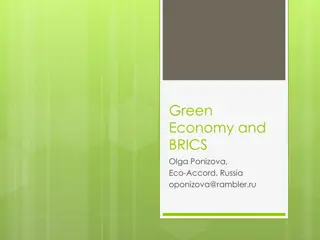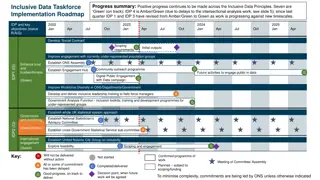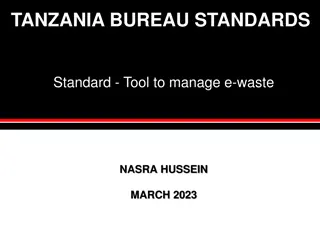Evolution of Green Development Standards: Progress and Policies
The evolution of green development standards showcases advancements in energy efficiency, sustainability, and policy implementations. From voluntary to mandatory standards, municipalities have adopted green incentives and checklists to promote environmentally friendly development. Recent amendments to planning acts highlight a growing focus on climate change mitigation and adaptation in development regulations.
Download Presentation

Please find below an Image/Link to download the presentation.
The content on the website is provided AS IS for your information and personal use only. It may not be sold, licensed, or shared on other websites without obtaining consent from the author. Download presentation by click this link. If you encounter any issues during the download, it is possible that the publisher has removed the file from their server.
E N D
Presentation Transcript
Green Development Standards Where We Are At Now ..Updates (as of ) Friday November 9th, 2018
The Evolution of the Green Development Standards Story Energy Star and LEED Requirements Green Development requirements on specific lands Sustainability checklists Green Development Incentives (DC rebates, density bonusing, streamlining green applications) Voluntary Standards Mandatory Standards Policy Advancement
GDS Implementation Mid 2000 s a number of municipalities developed GD checklists/incentives Uptake (insert sad face here) but did serve an educational outcome East Gwillimbury- Energy Star for new homes. Vaughan followed shortly thereafter 2006 Toronto Green Standard (voluntary) ; Tier 1 mandatory in 2010; Tier 2 incented via DC rebate 2008 Vaughan, Richmond Hill and Brampton jointly develop GDS Halton Hills requires GDS process and level Mississauga adopts Green Development Strategy - but aligns it with stormwater fee) Uptake increases (funny that ah?!)
Planning Act Bill 51 amendments to Planning Act provide for exterior sustainable design elements as part of Site Plan control. Site Plan Approval s. 114(5)2. iv) also Section 41 of the Planning Act Often requires Official Plan Update. Ex. Richmond Hill The Town shall develop Sustainable Design Criteria to ensure the sustainable design policies of this Plan are addressed through individual development applications . Policy 3.2.3(2) of RHOP: The Site Plan Control By-law to be enacted by Council shall provide that for the purposes of ensuring consistency with the requirements of this Plan, high quality exterior design and the incorporation of sustainable design elements, the following matters (among others) shall be subject to the approval of Council: a. Matters relating to exterior design, including without limitation to the character, scale, appearance and design features of buildings and their sustainable design; (Policy 5.14(3) of RHOP)
Municipal Act Change to Planning Act Adding Climate Change as a Provincial Interest: Section 2 of the Planning Act 11. (1)Section 2 of the Planning Act is amended by adding the following clause: The mitigation of greenhouse gas emissions and adaptation to a changing climate
Provincial Policy Statement 1.8 Energy Conservation, Air Quality and Climate Change 1.8.1 Planning authorities shall support energy conservation and efficiency, improved air quality, reduced green house gas emissions and climate change adaptation through land use and development patterns which: a) Promote compact form and a structure of nodes and corridors; b) Promote the use of active transportation and transit in and between residential employment and institutional uses and other areas c) Focus major employment, commercial and other travel intensive land uses on sites which are well served by transit where this exists or is to be developed, or designing these to facilitate the establishment of transit in the future; d) Focus freight intensive land uses to areas well served by major highways, airports, rail facilities, and marine facilities. e) Improve the mix of employment and housing uses to shorten commute journeys and decrease transportation congestion; f) Promote design and orientation which: maximizes energy efficiency and conservation, and considers the mitigating effects of vegetation; and maximizes opportunities for renewable energy systems and alternative energy systems; and g) Maximize vegetation within settlement areas, where feasible.
Updates to Municipal Act/COTA Act Change # 1: Schedule 1: added in: Economic, social and environmental well being of the municipality, including respecting climate change. Change # 2: Green Standards and Green/Alternative Roofs: Environmental Standards, construction of buildings Authorize a local municipality to pass a by-law respecting the protection or conservation of the environment that requires buildings to be constructed in accordance with provisions of the building code under the Building Code Act, 1992 that are prescribed under that act, subject to such conditions and limits as may be prescribed under that Act.
Municipal Act/ COTA Act (cont ) Green Roofs or alternative roof surfaces Without limiting sections 9,10 and 11, the power described in subsection (1) includes the power to require the construction of green roofs or alternative roofs surfaces that achieve similar performance to green roofs. Change # 3: Municipalities may provide for or participate in long-term energy planning for energy use in the municipality. Change # 4: 33. Subsection 270 (1) of the Act adds in: The manner is which the municipality will protect and enhance the tree canopy and natural vegetation in the municipality.
OBC and Municipal/COT Act Building Code is still king municipalities still do not have the authority to mandate energy efficiency standards above building code Developers can volunteer to build above code but those above minimum code items need to be agreed to by the developer and implemented through site plan or subdivision agreements Once agreed to and signed on though they became a requirement to follow through on Enforcement is a challenge though How could the MA/COTA work together with the building code? Possible Opening: If there are voluntary standards/measures in the OBC; then there could be the option to make them mandatory through a municipal GDS. This is not yet the case, but the next OBC update could include it. It would likely require a concerted effort by municipalities to get this possibility in place.
Green Development Standard Resources Link to Clean Air Council Green Development Standards Resources
Lesson Learned Thus Far Consistency, Flexibility and Continuous Improvement Voluntary/Mandatory/Timing: When the GDS metrics are advanced with developers Metric Uptake and Performance Monitoring Building Energy Use (how to address this) Inter-departmental GDS Development and Implementation Team Planner & Staff Training The Business Case of GDS (what does it cost a municipality not to have a GDS)?
Roundtable Updates For those in the stage of developing a Green Development Standard any information on the below would be great: If working from council mandate or from senior decision making mandate (where is there support for a mandate to explore Green development standards)? Consultations that have been undertaken/planned? Process and timeline? Hoped for/Planned outcome from green development standards work being undertaken and timeline? Other sharing you deem useful?
Roundtable Updates For those with Green Development Standards in place any info/update you can provide any updates on the below over the last year (2017) would be great: Status? Is it required or voluntary? Any updates/research planned for metrics/standards? How processing and review is managed? How compliance is being secured? How standards/metrics are being monitored, tracked and reported on? Any incentives? Or other mechanism to further uptake? In place? Under consideration of such? Info on staff allocations? Issues encountered?
GDS Possible To Dos New Municipal Council: Green Development Standard COP participation memo (white paper and scan can support that) to get council/senior management support for exploring the development of GDS Identify wording used in those jurisdictions that have GDS have incorporated into their OPs, SPs, etc. Case Studies on GDS implementation: what measures are getting implemented. What the developments look like. What makes them greener. Dog and Pony Show: Peers in jurisdictions that have a GDS visit those where they trying to advance them Metrics Update: ex. environmentally sensitive areas; climate change adaptation, ghg specific metrics Incentive and Financing mechanisms how to address any upfront capital cost increases from green metrics Builder outreach Those that participate; better understand builder resistance
City of Toronto Update Council adopted Toronto Green Standard (TGS) v3 on Dec. 7, 2017 including the energy and GHG stepped and capped EUI targets to 2030 zero emissions for new construction. It took effect on May 1, 2018 for all new development applications. Part of Transform TO - TGS energy targets if implemented and rolled in every four years as planned, will reduce 30.6 MT of C02 by 2050 The updated TGS now includes 4 tiers or levels of environmental performance across the five categories -air quality, GHG reductions/resilience, water efficiency/quality, ecological design and solid waste reductions. Tier 1 continues to be mandatory implemented using authorities for 'matters of exterior sustainable design' under section 41 of the Planning Act and the other Tiers are voluntary.
City of Toronto Update Energy performance requirements above the Code are implemented through the requirement for a "design development stage energy modelling report" submitted and reviewed prior to site plan approval. That report has a terms of reference included in our application requirements for studies and reports and is viewed as equal to submitting a storm water management or tree preservation report. That report has a terms of reference included in our application requirements for studies and reports and is viewed as equal to submitting a storm water management or tree preservation report. We also provide incentives for energy above come through HPNC and for all TGS Tier 2 and above through the Development Charge Refund Program.
City of Toronto Update Review is managed across five business units for review for specific TGS items as part of their regular business. Compliance is secured on approved plans and drawings and in reports and via site plan conditions in the site plan agreement and regular site inspections. Top issue is capacity. Have a very small group in City Planning that creates TGS and procedures and trains as well as all of other policy and planning work. Also review and clear TGS Tier 2 projects through SPA, and are a commenting unit. The TGS has successfully influenced the OBC energy requirements and now a new CSA Canada wide standard is being developed for bird collision deterrence with committee chair from our group, Kelly Snow, who developed the City's bird friendly and light pollution reduction requirements.
City of Toronto Update The Development Charge refund is still in effect and awarded to Tier 2 and above. There is no new tiered financial incentive offered for the higher tiers unfortunately but we were counting on cap n trade dollars to top Tier 3 and 4 projects up. We continue to look to develop additional financial and non-financial incentives but without them we are already seeing a number of Tier 3 or 4 projects coming through and developers committing to Tier 2 or higher even with the more challenging energy targets under V3. Some examples of high performance buildings coming in under V3 include: University of Toronto student residence, TRCA head office, next phases of Regent Park (TCH) and the City of Toronto Mt Denis Childcare Centre (net zero).
Burlington and Clarington Burlington: In the process of developing a Sustainable Building Development Guideline. New OP has incorporated Climate Change and identified increasing the sustainability of new developments as a priority action area. Clarington: Has a GD Framework: checklist for secondary plans, subdivisions and site plans. Undertaken consultations with community and developers. In 2016, a new Community Improvement Plan (CIP) was developed that considered the Green Development Framework. This plan incorporated a Tax Increment Grant Incentive Program (TIGIP) that evaluated site plan applications and credited developers to receive varying degrees of financial incentives depending on the green development elements incorporated into their building designs. Check out PRIORITY GREEN Clarington
Town of East Gwillimbury East Gwillimbury is reviewing and updating the Thinking Green! Development Standards (TGDS), which were originally approved in 2012. The Town requires that the TGDS be submitted as part of a complete application for community design plans, draft plans for subdivision and site plan applications. This direction is set out in the Town s Official Plan. The draft builds on the existing standards but looks to update the program to reflect updates to OBC, to improve clarity for applicants and reviewers, and maintain flexibility. For more information, check out the Thinking Green! Development Standards draft program.
Richmond Hill, Vaughan and Brampton Mandatory Green Development Standards Process Developers need to complete their GDS process with their first filing identifying the metrics they chose to implement as part of their development. Developers choose the metrics but they are required to achieve a minimum points threshold (municipality allocates points to each sustainability metric) for their application. Inter-departmental collaboration and processes are key to review/implementation. Training of planners to promote metrics is also key. Regular reviews and updates to metrics and process.
City of Vaughan Update Green Development Standards program is moving through a testing stage. City has: Identified appropriate building performance thresholds (bronze, silver and gold) as derived from data gathering efforts during the testing stage. Made clarifications to the performance metrics to be used Undertaken staff training activities Undertaken community outreach activities with the York chapter of Bild City is streamlining implementation efforts by: Ensuring planners are circulating sustainability metric materials appropriately to developers; Ensuring that planners are providing recommendations to applicants on how to achieve higher sustainability point scores to meet the performance expectations as per City Council. Delivering staff additional training and consultation where skill/expertise gaps arise, this has been a critical driver to Planning Department buy-in and self-sustaining implementation. Ensuring performance metrics align with recent provincial legislative updates and existing best practices. City is also producing a Green Development Standards Toolkit (ideally online) as an one-stop information package for developers to add simplicity and clarity.
Town of Halton Hills Similar process and metrics to Vaughan, Brampton and Richmond Hill GDS. Looking to advance resilience opportunities Town is developing a Secondary Plan for a 1,000-acre new community in a greenfield area. As a subcomponent of the plan, the Town is developing an Energy Conservation and Water Conservation Strategy and a Sustainable Neighbourhood Design Guideline (required in the Terms of Reference for the Secondary Plan). These new mechanisms will be considered to be incorporated within the broader encompassing GDS Checklists updates. Town of Halton Hills Green Development Standards and Strategy.
City of Mississauga For the current GDS the City focused on metrics that related to stormwater and reducing flooding risk; therefore LID features and precipitation on-site practices were the primary area of focus. A focus was placed on educating and increasing awareness through municipal departments (not just the planning department) about the benefits associated with LID measures. Connected with their stormwater charge mechanism increased uptake.
City of Mississauga Update City currently has 3 different strands of work: 1) City is developing a Climate Action Plan (corporate & community, adaptation & mitigation) containing green development standards (to be integrated into their OP). 1) OP integration process plans to insert more language around green development standards and/or sustainability-related recommendations for land use planning and development at the strategic level. 2) Legal Department has been examining Bill 68 ( Modernizing Ontario s Municipal Legislation Act 2017 ). 1) City has identified that Bill 68 gives municipalities increased authority to create bylaws requiring building sector GHG emission reductions. 3) City continues to focus on stormwater management-related performance metrics and the implementation of stormwater LID features across the city.
City of Markham Markham s GDS Checklist is in a draft form and is being reviewed by senior management. In addition, consultations are taking place between the City and the development community. The City has not developed any incentives as of yet but there are requirements for developers building on greenfield areas located north of Markham to submit energy plans.
City of Kitchener Update City is currently in a planning stage over Green Development Standards. Consultations are ongoing between Waterloo, Cambridge and Kitchener municipalities and NGOs to identify next steps in the development of a regional approach to standards. Local planning heads and chief building officials have recently joined and reinvigorated discussions. City also has 2 other items: 1) Urban Design Manual 1) This piece is under review to include more sustainable development guidelines. 2) Sustainability statements 1) Developers are required to submit a sustainability statement, as per a Terms of Reference in their OP, on their sustainability metrics. 2) This piece is under review. Current issues: 1) 2) Staff capacity Development community engagement
Town of Innisfil The municipality is in a very early exploratory stage on green development standards program. Staff are interested in connecting with other small municipalities to share knowledge, experience and lessons learned.


